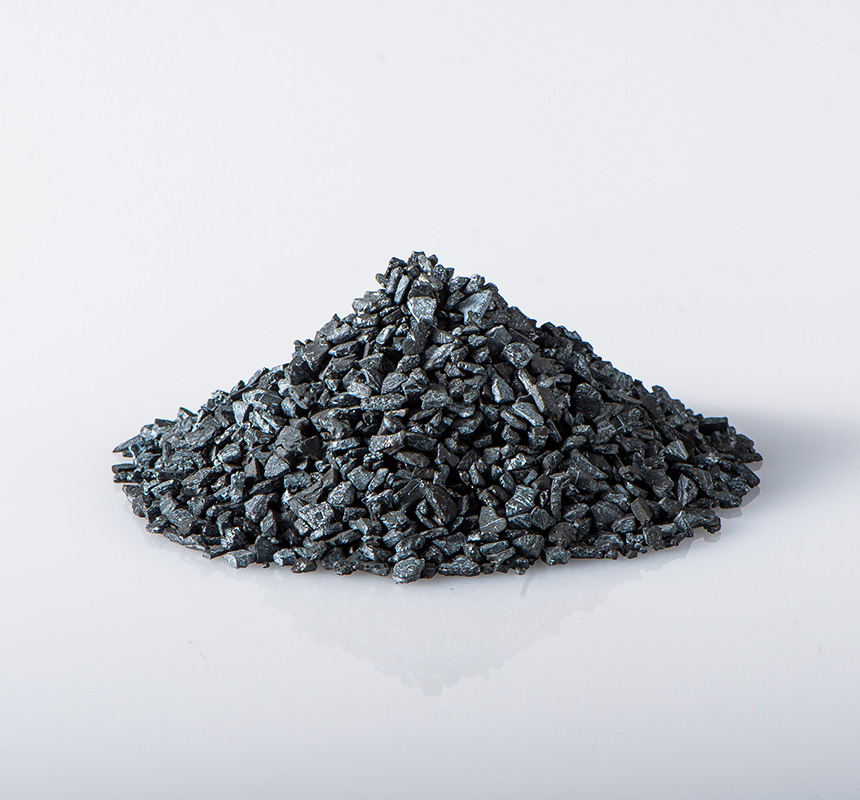Photocatalytic Activated Carbon
(Trade Name: CRI-up®)
- Item No.
- KDX

Decompose & Purify with the Power of Light
Photocatalytic Activated Carbon (KDX) (Trade Name: CRI-up®) is a composite functional activated carbon that combines high-quality coconut shell activated carbon, excellent in adsorption, with titanium oxide photocatalyst, which generates active oxygen upon light irradiation. It simultaneously leverages the physical adsorption of activated carbon and the decomposition action of titanium oxide to provide environmental functions such as antibacterial, anti-mold, and water quality improvement.
Features
- Hybrid Effect of Adsorption and Decomposition
- Activated carbon adsorbs fine particles and fungi, while titanium oxide generates active oxygen (e.g., OH radicals) under light irradiation. This chemically decomposes and detoxifies adsorbed pollutants.
- Antibacterial and Anti-Mold Performance
- The photocatalytic action suppresses the proliferation of bacteria and mold. It is suitable for long-term use in outdoor and humid environments.
- Environmentally Friendly and Highly Safe Design
- Titanium oxide is highly stable, does not leach additives, and can be safely used in water contact applications.
Comparative experiment
Pre-testing situation --> After inputting CRI-up® (75 days)
UES photocatalytic activated carbon (Trademark: CRI-up®) is an activated carbon in
which titanium oxide is integrated into coconut shell activated carbon with superior adsorption action.
Photocatalysts release reactive oxygen through sunlight, which results in an antibacterial and
antifungal effect (US PAT acquired, US 6,673,738 B2)
Application
Water Purification Applicationsf
It is utilized to suppress the growth of algae (e.g., Aoko) and microorganisms in water contact environments exposed to sunlight (e.g., ponds, fountains, waterways).
Technical data
CRI-up® component analysis test
| Cadmium or its compounds | mg/L | Not detected | 0.01Less than |
|---|---|---|---|
| Cadmium or its compounds | mg/L | Not detected | 0.01Less than |
| Cyanides | mg/L | Not detected | 0.01Less than |
| Hexavalent chromium compounds | mg/L | Not detected | 0.01Less than |
| Arsenic or its compounds | mg/L | Not detected | 0.005Less than |
| Mercury or its compounds | mg/L | Not detected | 0.0005Less than |
| Mercury or its compounds | mg/L | Not detected | 0.0005Less than |
| Organic phosphorus or its compounds | mg/L | Not detected | 0.01Less than |
| PCB | mg/L | Not detected | 0.0005Less than |
| Selenium or its compounds | mg/L | Not detected | 0.005Less than |
※February 17, 1971 Make a test solution with Notification No. 13 of the Environment
Agency
(Gamma Analysis Center)
CRI-up® water purification test
| Pond water | River water | Seawater | ||||
|---|---|---|---|---|---|---|
| Raw water | CRI-up®treated water | Raw water | CRI-up®treated water | Raw water | CRI-up®treated water | |
| Hydrogen ion concentration (17°C) pH | 7.8 | 7.8 | 8.0 | 8.7 | 8.3 | 7.8 |
| Biological oxygen demand mg/L | 8 | 3.2 | 10 | 4.4 | 10 | 3.5 |
| Chemical oxygen demand mg/L | 14 | 10 | 9.0 | 9.2 | 13 | 7.3 |
| Amount of floating substances mg/L | 45 | 11 | 28 | 11 | 25 | 15 |
| Normal hexane extractable material content mg/L | 1Less than | 1Less than | 1Less than | |||
| E. coli group number MPN/100 mL | 7.9×10 2 | 2Less than | 3.3×10 2 | 2Less than | 2Less than | 2Less than |
| Nitrogen content mg/L | 1.7 | 0.94 | 4.7 | 3.4 | 1.9 | 1.3 |
| Phosphorus content mg/L | 0.12 | 0.05 | 0.31 | 0.11 | 0.07 | 0.07 |
※Filter with a 1mm filter (after SS filtration). Use the filtrate as the analytical
sample. (However, SS and E. coli group numbers are excluded)
※CRI-up® is UES' photocatalytic activated carbon integrating titanium oxide and activated
carbon. US Pat. No. 6,673,738, B 2Ocean-guard CRI-up® also uses the same raw materials, so please
refer to the above as reference data. (Gamma Analysis Center)
Quality specifications(analysis example)
| Shape | Granular |
|---|---|
| BET surface area | 1095.6㎡/g |
| Hardness | 98.6% |
| Particle size(MESH) | 4×8 |
| Packing density | 0.60g/㎤ |
| Ash content | 1.2% |
| Loss on drying | 8.7% |
| Minimum Lot | Please contact us |

